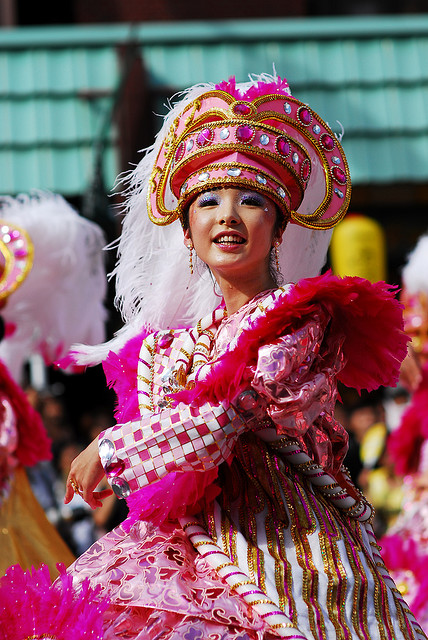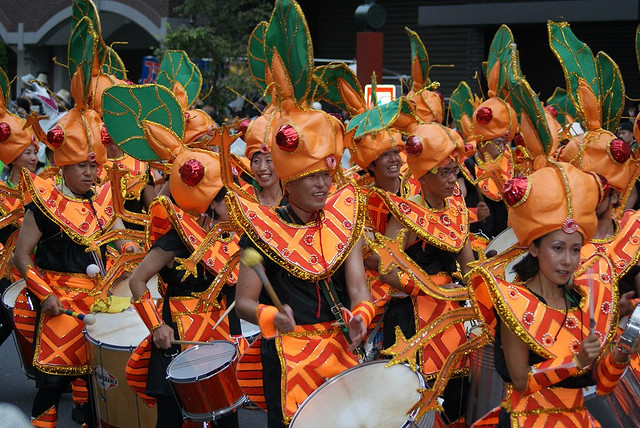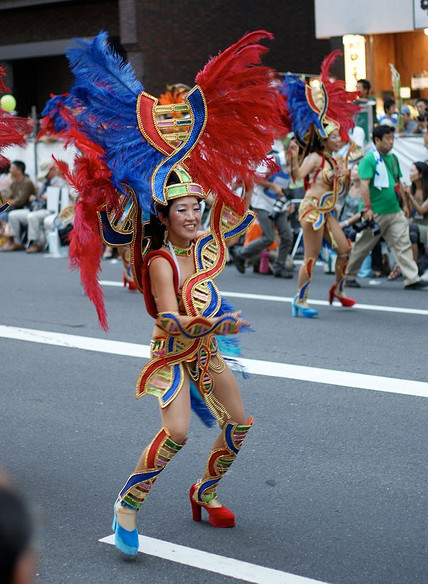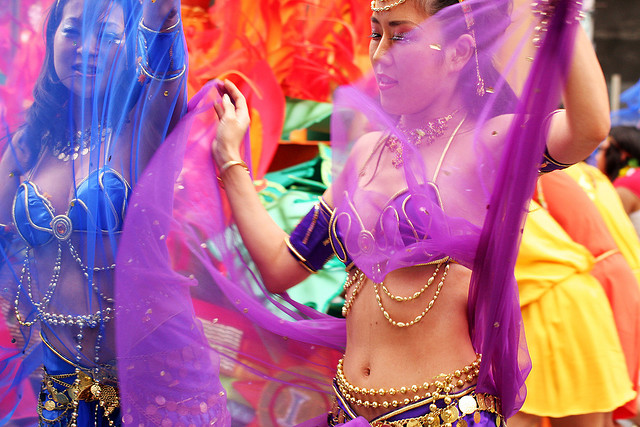Asakusa Samba Carnival
Samba may be something you associate more with Rio than Japan, but Tokyo’s Asakusa district has a samba tradition that stretches back more than thirty years. Asakusa was once Tokyo’s downtown, but by 1981 it had become a bit of a shabby backwater. Local people decided they needed to do something to reinvigorate the area,

Many performers wear ornate costumes like this one. They can’t be very comfortable in the summer heat.
and so they launched the Samba Carnival. It’s been going strong every since, and now has the most performers of any samba carnival outside of Brazil.
Samba was little-known in Japan before the launch of the festival, but the carnival is now one of Tokyo’s best known events, attended annually by about 500,000 spectators. In the first years of the festival, many of the performers where new to samba, having previously performed in Asakusa’s traditional Bon Odori dance, but they fervently adopted the new style. The popularity of the carnival has no doubt been helped by Japan’s not inconsiderable Brazilian population – partly made up of the descendants of émigrés who left Japan during the twentieth century to work on Brazil’s coffee plantations.
The carnival takes the form of a parade in which around thirty or forty samba groups process along the streets of Asakusa, dancing, singing and playing instruments as they go. The biggest groups have more than 250 performers, most of who go on foot, but some ride atop elaborately decorated floats. The groups are divided into a first and second division, and each year teams are promoted and demoted depending on the judges’ rating of their performances. Some teams practice hard and intensively all year long, doing their best to create performances true to Brazil’s samba tradition. Others are just in it for the fun, and put more emphasis on ‘Joy through samba’ than on technical skill and accurate choreography.

Percussionists from one samba team’s band. I’m not quite sure what they are dressed up as, but they seem to be enjoying themselves.
A lot of effort is put into making the costumes and floats. Colorful plumes and thousands of sequins are combined with a huge amount of originality and creativity to produce fabulous outfits, some of which are so big you can hardly see the performers inside. Most groups adopt a consistent theme each year, so when all the performers parade together they make a powerful visual impact. Some teams try to create a glamorous spectacle, but others go for the funny and ridiculous. Each group is accompanied by its own band, in which drums and Latin-American percussion instruments feature strongly. Shouting and singing – as often as not in Portuguese – adds to the storm of sound emanating from the instruments.
Most of the performers are young women, but there are kids, men and older performers too, and some of the samba groups are from high schools or universities. Every year, the winning team from the Rio Carnival is invited to Asakusa, and parades alongside the local teams. In true Rio tradition, many of the female dancers twirl and shake in front of the onlooking crowds wearing almost nothing at all.

Some of the teams put a huge amount of work into making their costumes, and feathers and giant headdresses like these are a popular feature.
There’s no doubt that the spectators enjoy these sexy displays just as much as the dancers enjoy showing off. The whole event has an anything-goes feel to it – it’s a chance to loosen inhibitions and freely display passion and enthusiasm.
A prize is awarded to the best team as decided by the judges, and another based on mobile-phone voting by the general public. On top of this there are extra prizes awarded by carnival sponsors. There’s an overwhelming atmosphere of festivity throughout Asakusa, and the whole parade is one big mass of energy and exuberance. The Asakusa Samba Association states that its aims are to make people smile, and give them hope and pleasure – and there’s no doubt that they are successful.
The carnival is held on the afternoon of the last Saturday in August, so expect it to be hot and very humid. The teams of the upper division parade last, after those that are less highly rated, and the teams that are really just in it for the fun. Along the route of the parade, there are plenty of stalls selling traditional festival food such as yakitori and takoyaki. Details are given on the official website. The official site is only in Japanese, but this machine translated version should give you all the information you need. To get there, travel to Asakusa Station which is on Toei Subway’s Asakusa line and Tokyo Metro’s Ginza line. When you exit the station, it’s just a case of following the crowds. If you want to be sure of a good view, arrive at least a couple of hours before the start of the festival.
Sapporo Snow Festival Hanami

